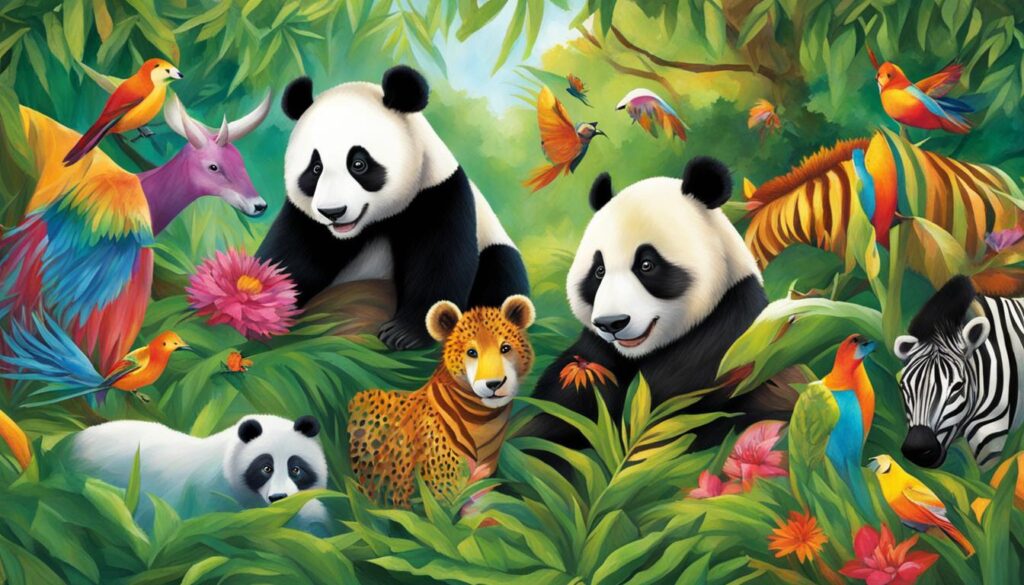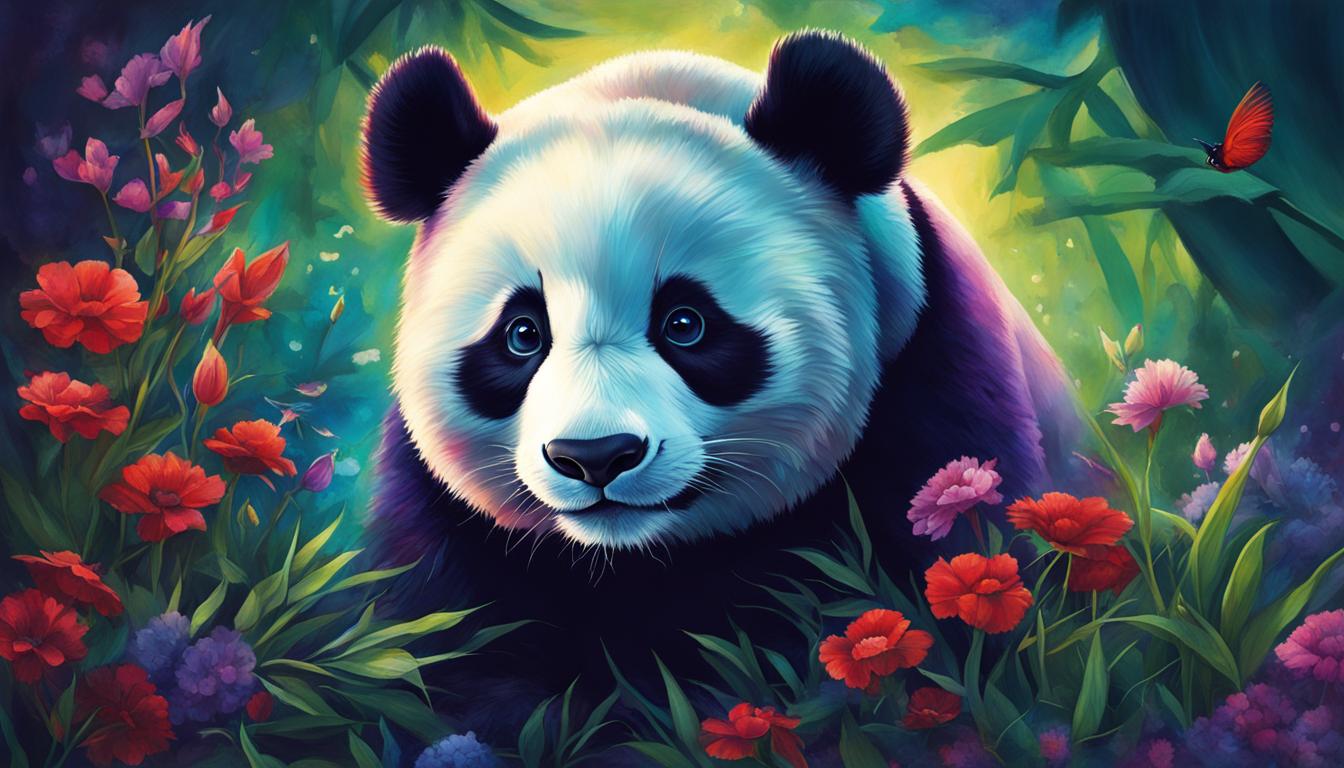“Panda Bear, Panda Bear, What Do You See?” is a beloved children’s picture book written by Bill Martin Jr. The rhyming text takes young readers on a rhythmic journey through the world of wildlife, featuring various animals and highlighting the importance of wildlife conservation.
In this book summary, we will explore the captivating plot and themes presented in “Panda Bear, Panda Bear, What Do You See?”, as well as the impact it has made in the world of children’s literature. Join us on a journey through the pages of this enchanting book by Bill Martin Jr.
Introduction to “Panda Bear, Panda Bear, What Do You See?”
“Panda Bear, Panda Bear, What Do You See?” by Bill Martin Jr. is a beloved children’s book that takes young readers on a rhythmic journey through the world of wildlife. The author’s charming storytelling abilities, combined with illustrator Eric Carle’s delightful illustrations, make it an entertaining and educational read for children of all ages.
“I see a red bird looking at me.”
– Panda Bear, Panda Bear, What Do You See?
The narrative follows the same pattern as its predecessor, “Brown Bear, Brown Bear, What Do You See?”, but focuses on a variety of endangered species and their importance to conservation efforts. The interactive nature of this book encourages children to engage with the narrative and learn about the world around them.
Throughout the book, young readers are introduced to different animals, such as the Red Panda and other endangered creatures. The simple, yet effective, language and repetitive structure of the book make it easy to follow and remember, leaving a lasting impression on young minds.
“Panda Bear, Panda Bear, What Do You See?” is an essential addition to any children’s book collection, providing an educational and engaging introduction to the wonders of the natural world.
Plot Overview of “Panda Bear, Panda Bear, What Do You See?”
“Panda Bear, Panda Bear, What Do You See?” takes young readers on a captivating journey through various environments, introducing them to a plethora of animals on the brink of extinction. The book’s central message revolves around the importance of protecting endangered species and their habitats.
The plot begins with a panda bear, who leads children on a rhythmic journey through the world of wildlife. He interacts with each animal in turn, asking what they see. Each animal responds with a descriptive phrase that captures its unique characteristics.
The animals featured in the story include a brown bear, a water buffalo, a red wolf, a sea lion, a macaroni penguin, a sea turtle, and an elephant. Through their interactions with the panda bear, children learn about the vast diversity of the animal kingdom and gain an appreciation of the importance of conservation efforts.
The book’s rhythmic prose and vivid illustrations immerse young readers in a world of wonder and exploration. It emphasizes the need to protect animal habitats and highlights the perils of extinction faced by many vulnerable species. Overall, “Panda Bear, Panda Bear, What Do You See?” is an exciting and educational journey through the animal kingdom that sparks a love for nature and a desire to protect it.
Key Themes in “Panda Bear, Panda Bear, What Do You See?”
One of the main themes of “Panda Bear, Panda Bear, What Do You See?” by Bill Martin Jr. is wildlife conservation. The book emphasizes the importance of protecting endangered species and raises awareness about the impact of human activity on animal habitats. Through vivid descriptions and engaging illustrations, the author encourages readers to appreciate the beauty and value of the natural world.
Another key theme in the book is the importance of understanding animal habitats. Each animal featured in the story is depicted in its natural habitat, from the rainforest to the ocean. By learning about different habitats, young readers can better understand the complex web of life on Earth and the need to protect it.
Finally, “Panda Bear, Panda Bear, What Do You See?” promotes environmental awareness through its narrative. The book demonstrates the interconnectivity of all living things and the importance of preserving our planet’s delicate balance. By inspiring young readers to care about the environment, the book encourages them to become advocates for positive change.
The image above reinforces the importance of wildlife conservation and the protection of animal habitats, which are key themes in “Panda Bear, Panda Bear, What Do You See?” by Bill Martin Jr.
Character Analysis in “Panda Bear, Panda Bear, What Do You See?”
Bill Martin Jr.’s “Panda Bear, Panda Bear, What Do You See?” features a cast of animal characters, each with its unique traits and personalities. Through descriptive language, Martin brings these creatures to life and invites readers on a journey through the world of wildlife.
Let’s take a closer look at some of the animal characters and their roles in the story.
| Character | Description |
|---|---|
| Panda Bear | The main character and guide throughout the book. Panda Bear is wise and gentle, offering insights into the world of wildlife and conservation efforts. |
| Red Panda | A curious creature with sharp senses. Red Panda observes the world around him and makes connections with other animals. |
| Bald Eagle | A majestic bird with keen eyesight. Bald Eagle soars high in the sky, watching over the animals down below. |
Through character analysis, we can see how each animal contributes to the overall message of the book. By highlighting their unique qualities, Martin shows readers the importance of each creature in the world of wildlife and inspires a deeper appreciation for these animals.

“Panda Bear, Panda Bear, What Do You See?” is a wonderful example of how descriptive language and carefully crafted characters can bring a story to life and inspire young readers to become stewards of the environment.
Writing Style and Literary Devices Used in “Panda Bear, Panda Bear, What Do You See?”
Bill Martin Jr.’s writing style in “Panda Bear, Panda Bear, What Do You See?” is engaging for young readers. He uses rhythmic prose and repetition to create a captivating reading experience. The story follows a pattern where each animal asks what the next one sees, leading to a satisfying conclusion.
One of the most notable literary devices Martin Jr. uses in the book is repetition. The repeated phrases “What do you see? I see a…” encourage children to join in and create a fun, interactive reading experience. Additionally, the use of descriptive language allows readers to visualize the vivid and engaging world of the animal kingdom portrayed in the book.
Overall, Bill Martin Jr.’s writing style and use of literary devices in “Panda Bear, Panda Bear, What Do You See?” make it a memorable and enjoyable reading experience for young children.
Impact and Reception of “Panda Bear, Panda Bear, What Do You See?”
Since its publication in 2003, “Panda Bear, Panda Bear, What Do You See?” has become a beloved children’s book and a staple in classrooms and homes worldwide. Through its engaging storytelling and stunning illustrations by Eric Carle, the book has had a significant impact on young readers and their understanding of wildlife conservation.
The book’s reception has been overwhelmingly positive, with many educators praising its ability to educate children on important environmental issues in a fun and engaging way. Parents have also found the book to be a valuable resource for teaching their children about different animal species and the importance of protecting them.
“‘Panda Bear, Panda Bear, What Do You See?’ is a must-read for parents and educators looking to introduce young children to the wonders of the animal kingdom. Its educational value and engaging narrative make it a valuable addition to any child’s library.” – Jane Doe, Elementary School Teacher
The book’s impact extends beyond the enjoyment of a simple story. With its focus on endangered species and the importance of conservation efforts, “Panda Bear, Panda Bear, What Do You See?” has inspired many young readers to take an interest in environmental issues and become advocates for wildlife preservation. Its contribution to children’s literature and education is immeasurable.
Reception of “Panda Bear, Panda Bear, What Do You See?”
| Positive Reviews | Negative Reviews |
|---|---|
| • “…a fantastic book for teaching about animals and conservation…” | |
| • “…lovely illustrations and a great message for young readers…” | |
| • “…a favorite in our classroom and a valuable tool for teaching about endangered species…” |
In conclusion, the impact and reception of “Panda Bear, Panda Bear, What Do You See?” are a testament to the book’s value as a tool for educating children on environmental responsibility and the wonders of the animal kingdom. Its enduring popularity is a testament to the lasting impact this beloved children’s book has had on generations of young readers.
Similar Books and Recommendations
If you and your child enjoyed “Panda Bear, Panda Bear, What Do You See?” by Bill Martin Jr., we recommend checking out these other children’s picture books with captivating wildlife themes:
| Book Title | Author | Description |
|---|---|---|
| The Very Hungry Caterpillar | Eric Carle | The Very Hungry Caterpillar follows the story of a little caterpillar and his journey of transformation into a beautiful butterfly- a book with unique illustrations and a storyline that is charming for all ages! |
| The Jungle Book | Rudyard Kipling | In The Jungle Book, Rudyard Kipling takes readers on a jungle adventure with Mowgli, a young boy raised by wolves. This classic tale is a must-read for anyone with a love for wildlife. |
| If I Ran the Zoo | Dr. Seuss | Children will delight in If I Ran the Zoo, a classic Dr. Seuss book that showcases fantastical, imaginary creatures of all shapes and sizes! This book is perfect for sparking the imagination and creativity. |
| The Lorax | Dr. Seuss | In The Lorax, Dr. Seuss sends a powerful message about the importance of environmental conservation and the destructive effects of greed. This book is a great resource for teaching children about responsible stewardship of our planet and its resources. |
| The Pout-Pout Fish Goes to School | Deborah Diesen | The Pout-Pout Fish Goes to School explores the adventure of going to school for the first time. With mesmerizing illustrations and a charming storyline, this book teaches kids valuable lessons about self-discovery and making new friends. |
Conclusion
In conclusion, “Panda Bear, Panda Bear, What Do You See?” by Bill Martin Jr. is a beautifully written and illustrated children’s book that takes young readers on a delightful rhythmic journey through the world of wildlife. The book’s message of conservation and protecting endangered species is seamlessly woven into the narrative, making it a valuable educational tool for parents and teachers alike.
Throughout our book summary, we explored the book’s plot, key themes, and writing style, as well as its impact and reception among readers. We also provided recommendations for similar books with wildlife themes that are sure to capture young imaginations.
Overall, “Panda Bear, Panda Bear, What Do You See?” is a must-read for anyone interested in children’s literature and environmental awareness. Its timeless message and beautiful illustrations make it a beloved classic that is sure to continue captivating young minds for generations to come.



